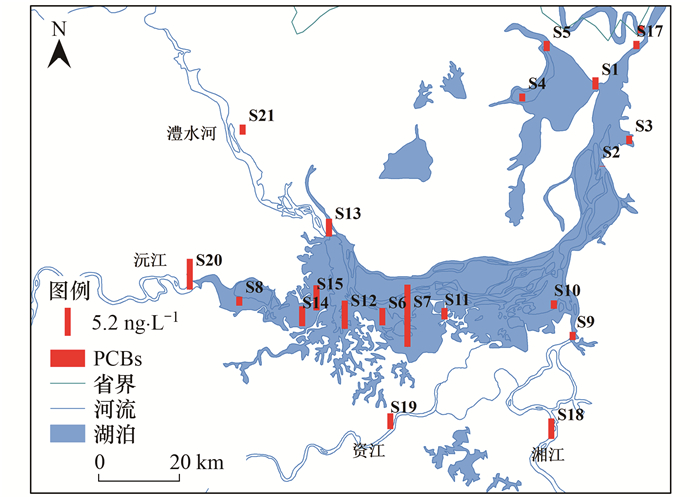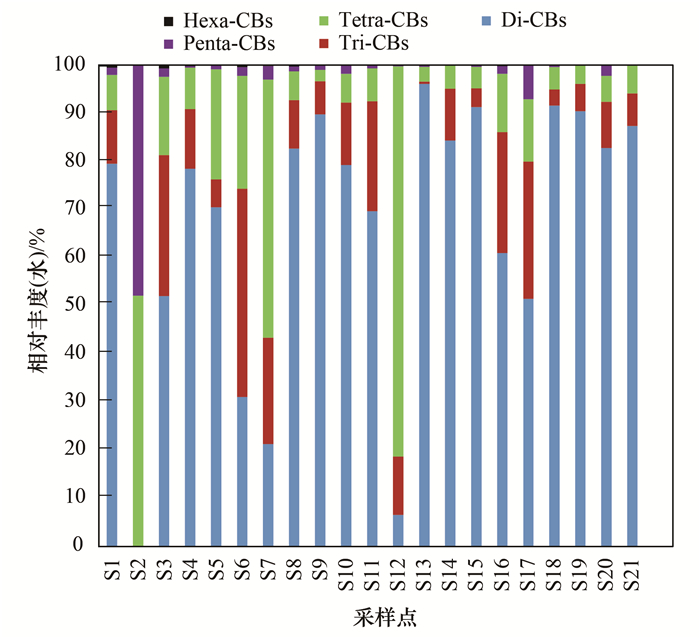2. 同济大学环境科学与工程学院, 上海 200092
2. College of Environmental Science and Engineering, Tongji University, Shanghai 200092, China
多氯联苯(polychlorinated biphenyls, PCBs)是一类人工合成的氯代芳香族有机化合物, 共有209种单体分子.PCBs具有“三致效应”, 在生态系统中能够对水生生物体产生毒害, 也能通过食物链累积与传递作用影响到高营养级生物体包括人类[1].尽管PCBs已被禁止使用和生产超过40 a, 但由于PCBs的高迁移性、持久性和难降解性, 在各种环境介质中几乎无处不在, 在大气、土壤、水、沉积物、动植物甚至人类母乳中均有检出报道[2~4].然而, 受限于仪器与检测方法, 大多数研究是在低分辨率的GC-MS基础上进行的, 难以排除其他化合物的干扰, 存在假阳性或者漏测的问题, 不能体现PCBs总浓度, 环境中的PCBs污染水平及生态风险可能被低估[5, 6].
洞庭湖位于湖南省北部, 是我国第二大淡水湖.湖区大致可分为东洞庭湖、南洞庭湖和西洞庭湖三部分, 南和西接湘、资、沅、澧四水及汨罗江等小支流, 由岳阳市城陵矶注入长江.作为长江流域重要的调蓄湖泊和饮用水源地, 保障洞庭湖水质和维护生态系统健康具有重要意义.近年来, 已有研究关注了洞庭湖中PCBs的残留情况.Wei等[7]的研究在2014年调查了东洞庭湖区水体中的7种指示性PCBs(In-PCBs)单体, 结果表明, ρ(PCBs)处于较低水平(0.50~2.8 ng·L-1).胡余明[8]的研究调查了洞庭湖13种鱼类组织中12种二
本文选取洞庭湖及入湖河流作为研究对象, 采用高分辨质谱仪对表层水中全部209种PCB同类物进行检测分析, 分析湖中PCBs的浓度水平与分布特征, 探讨其潜在来源, 评估其毒性风险, 以期为洞庭湖有机污染防治与生态安全保障工作提供数据支撑.
1 材料与方法 1.1 研究区域与样品采集在洞庭湖湖区、入长江口及4条入湖河流布设共21个采样点(图 1), 包括东洞庭湖(S1~S5)、南洞庭湖(S6~S11)、西洞庭湖(S12~S15)、湖区出口(S16~S17)和入湖四水(S18~S21).样品采集于2018年9月, 表层水样(0~50 cm)保存在1 L棕色玻璃瓶中, 采集水样前加入0.5 mL甲醇, 防止微生物生长.水样经玻璃纤维滤膜过滤去除悬浮颗粒物, 4℃冷藏保存待处理分析.

|
图 1 洞庭湖水域采样点分布示意 Fig. 1 Map of Dongting Lake area and sampling sites |
主要仪器: 高分辨气质联用仪(HRGC-HRMS, Agilent 6890-GC, Waters Micromass, Manchester, UK); 主要试剂: 农残级正己烷(n-Hexane)、二氯甲烷(Dichloromethane)、甲醇(Methanol)和丙酮(Acetone)购自Fisher (Fair Lawn, NJ, USA)和Tedia(Fairfield, OH, USA).标准溶液EC-4977(13C标记, 添加标)由EC-4979(13C标记, 注射标)Cambridge同位素实验室(Andover, MA, USA)提供, 209种PCB单体标准品购自美国Accusatandard公司.
1.3 样品预处理与分析采用固相萃取法对1 L水样进行富集后, 经旋转蒸发、氮吹浓缩至20 μL.样品通过同位素稀释-高分辨气相色谱-高分辨质谱法测定分析PCBs的组成.色谱柱DB-5MS(60 m×250 μm×0.25 μm), 仪器分析条件详见文献[9].
1.4 质量控制分析样品前, 进行精密度、回收率和实验室空白实验, 包括样品富集提取与仪器分析.在测样时进行实验中精密度和回收率实验, 每12个样品做一个全过程空白.本实验中PCBs检出限为0.060~0.10 pg·L-1, 回收率为56%~80%, 精密度为7.0%~23%.空白实验中的检出浓度低于样品的10%才有效.
1.5 数据分析对水中PCBs浓度之间进行关联分析, Pearson相关性分析在SPSS v22.0 (IBM Corp., Armonk, NY, USA)中完成, 对分析结果进行热图绘制, 其中P < 0.05表明具有显著相关性.使用单因素方差分析检测了不同区域PCBs浓度差异.
2 结果与讨论 2.1 PCBs浓度水平与空间分布PCBs在洞庭湖水环境中普遍存在, 各采样点均有不同浓度检出.水中总PCBs(∑PCBs)和In-PCBs浓度水平如图 2和表 1所示.水样中共有50种PCBs同系物检出, ρ(∑PCBs)在0.077~10 ng·L-1之间, 平均值为2.7 ng·L-1, 中值为1.9 ng·L-1.其中S7采样点浓度最高, S2采样点浓度最低.总体上来看, 洞庭湖流域水相环境中PCBs浓度水平在西洞庭湖及入湖支流要高于东洞庭湖与南洞庭湖, 在湖区出口处(入长江口)最低. ρ(∑PCBs)呈现入湖支流[(3.2±2.2)ng·L-1]>湖区[(2.7±2.4)ng·L-1]>湖区出口[(1.3±0.085)ng·L-1]的趋势.入湖河流中浓度相对较高, 可能是由于入湖口水流流速较快, 岸边土壤冲刷等作用携带了颗粒物吸附PCBs进入湖区, 这与徐磊等[10]在太湖竺山湾的研究结论是一致的.

|
图 2 洞庭湖水域∑PCBs与In-PCBs浓度分布 Fig. 2 Concentrations of ∑PCBs and In-PCBs in the Dongting Lake areas |
|
|
表 1 研究区域检出PCB单体及浓度分布1)/ng·L-1 Table 1 Distribution of PCB congeners detected and concentrations in the study area/ng·L-1 |
在所有检出的PCB同类物中, 检出率高于80%的包括PCB11、PCB17、PCB18、PCB20+33、PCB28、PCB47+75、PCB52和PCB68.其中, 检出率最高的是PCB11(95%), 且ρ(PCB11)最高, 平均值为1.6 ng·L-1. 7种In-PCBs中有5种检出, 分别为PCB28、PCB52、PCB101、PCB118和PCB153. ρ(In-PCBs)在0.018~1.4 ng·L-1之间, 仅占ρ(∑PCBs)的1.4%~13%(图 2), 而12种dl-PCBs中仅有PCB118检出, 浓度范围在ND~0.026ng·L-1之间.因此, 仅检测In-PCBs和dl-PCBs并不能全面反映水中PCBs的污染水平, PCBs污染程度也受到一些其他单体的影响, 这也表明在相关水域研究中可能低估了PCBs的总浓度.
表 2汇总了国内外部分地区地表水环境中PCBs的检出情况.与我国其他地区地表水中PCBs总检出浓度相比, 本研究中ρ(∑PCBs)(0.076~ 10 ng·L-1)与洪湖(0.16~11 ng·L-1)和东洞庭湖(0.50~2.8 ng·L-1)相当, 明显低于淀山湖(19~39 ng·L-1)和白洋淀(19~132 ng·L-1), 但高于长江中段(0.002 0~0.16 ng·L-1)、黄河(0.64~2.3 ng·L-1)和太湖(ND~1.0 ng·L-1).与国外相关水域相比, 洞庭湖ρ(∑PCBs)较低, 远低于美国密西西比河(22~163 ng·L-1), 略低于意大利亚诺河(1.4~25 ng·L-1)和巴基斯坦拉维河(1.9~12 ng·L-1), 与马来西亚雪兰莪州河(0.13~7.7 ng·L-1)相当.值得一提的是, 不同研究中所检测的目标PCB同类物数不同, 且多数研究仅检测了几种至多几十种PCBs, 这会造成PCBs总浓度比较上的偏差.本研究检测了全部209种同类物, 但总体来说, 洞庭湖水体中PCBs的浓度在国内外水域中仍处于较低水平.
|
|
表 2 洞庭湖与国内外部分地区地表水环境中PCBs浓度水平比较1) Table 2 Comparison of PCBs concentration levels in the surface water environment between Dongting Lake and some areas at home and abroad |
2.2 PCBs组成与潜在来源分析
环境介质中PCBs同类物的组成通常能反映它们在环境中的来源、迁移和归趋等信息[20].我国PCBs的生产和使用时间相较于国外尤其是发达国家较晚, 且历时较短(20世纪60年代开始生产使用至20世纪80年代停产), PCBs多用于电力容器和润滑剂等.但由于生产和使用量较大, 造成管理难度大.洞庭湖是我国农工业重点发展区域, 历史遗留机械设备如果处置不当会对环境产生威胁.本研究中, 不同氯代CBs的浓度与相对丰度见表 1和图 3.从中可知, 洞庭湖水域表层水中PCBs以低氯代为主, 只有二~六氯代CBs检出.二氯联苯(Di-CBs)浓度最高(平均值1.7 ng·L-1), 在80%的样品中相对丰度>50%.其次是: 三氯联苯(Tri-CBs)>五氯联苯(Penta-CBs)>四氯联苯(Tetra-CBs)>六氯联苯(Hexa-CBs).PCBs类似的组成分布也在太湖[10]和白洋淀[21]等研究中报道.低氯代CBs在洞庭湖水环境中为主, 一方面是由于低氯代CBs的水溶性高于高氯代CBs, 且具有较高的蒸气压, 可以通过大气干湿沉降进入湖泊中[22].另一方面, 环境中某些微生物多有PCBs的降解脱氯作用, 使得高氯代CBs逐渐转向低氯代CBs[23].所有目标物中, PCB11在检出中浓度最高, PCB11是一种典型的非商业化的PCB单体, 在国产有机颜料生产过程中会无意排放至大气, 经大气传输在环境中远距离迁移[24, 25].我国是世界上最大的有机颜料生产国, 因此有机颜料生产所带来的大气中PCBs污染应当引起关注.另外, Tri-CBs浓度较高可能是源于该区域电容器和变压器等无意间的泄漏而产生的历史残留.Tri-CBs中PCB52占比最高, PCB52是我国历史上生产的三氯联苯商业混合物(Aroclor1242)中的主要成分.综上, 洞庭湖水域PCBs主要来自于大气传输沉降及历史残留.

|
图 3 洞庭湖表层水中各氯代PCBs相对丰度 Fig. 3 Relative abundance of PCB homologs in the surface water of the Dongting Lake area |
此外, S7点位ρ(∑PCBs)(10 ng·L-1)显著高于其他采样点(图 2), 经实地调查发现, S7采样点位于村庄附近且周边无正在运营的工厂, 因此高浓度的PCBs可能源自于居民日常生活中产生的电子垃圾排放以及变压器等的无意释放.
对洞庭湖水中PCBs进行Pearson相关性分析, 分析结果见图 4.水中Tri-CBs和Tetra-CBs(R=0.81, P < 0.01)、Penta-CBs(R=0.86, P < 0.01)和Hexa-CBs(R=0.60, P < 0.01)之间, Tetra-CBs和Penta-CBs(R=0.72, P < 0.01)之间均呈现出显著的正相关性, 表明他们可能存在共同的来源.此外, 尽管水中In-PCBs和dl-PCBs浓度很低(图 2和表 1), 但水中∑PCBs与In-PCBs(R=0.82, P < 0.01)和dl-PCBs(R=0.76, P < 0.01)之间仍呈现出强正相关性, 这和文献[6]的研究结果一致.这种显著的强相关性表明当实验条件受限无法检测209种PCBs时, 可以考虑使用In-PCBs或dl-PCBs来估算样品中PCBs总浓度.

|
*和**分别表示在0.05和0.01水平(双尾)相关性显著 图 4 地表水中PCBs之间的相关性热图 Fig. 4 Heatmap of correlation of PCBs concentrations among surface water samples |
水源地的PCBs污染会影响供水安全与生态系统健康, 考虑到PCBs的毒性和生物积累性, 评价洞庭湖地区PCBs潜在的生态风险具有重要意义.我国《地表水环境质量标准》(GB 3838-2002)和US.EPA(美国环保署)规定PCBs在水中的浓度限值分别为20 ng·L-1和14 ng·L-1, 洞庭湖水体中PCBs的浓度(0.076~10 ng·L-1)远低于我国地表水环境质量标准与EPA限值.因此, 洞庭湖地区的地表水环境质量受多氯联苯污染的影响较小, 表明水生态系统中目前的PCBs浓度水平可能不会对生态系统健康产生不利影响.
进一步地, 为了评估水样潜在的二

|
式中, c为PCB浓度, TEFs取自世卫组织2005年修订的数值[26].本研究洞庭湖水样中dl-PCBs的TEQ范围在ND~7.8×10-4 pg·L-1, 平均值为5.8×10-5 pg·L-1, 均远低于日本环境质量标准(1 pg·L-1)及美国EPA标准限值(30 pg·L-1).因此, 洞庭湖水域中PCBs污染产生毒性很小, 对水环境及水生生物几乎不产生危害.
3 结论(1) 首次对洞庭湖及入湖河流中的209种PCBs进行了全面调查.共检出50种PCB同类物, ρ(∑PCBs)在0.076~10 ng·L-1之间, 平均浓度呈现: 入湖支流>湖区>湖区出口的趋势.与国内外研究相比, 洞庭湖水域PCBs污染处于较低水平.
(2) 研究区域表层水中的PCBs以低氯代为主, 尤其是Di-CBs、Tri-CBs和Tetra-CBs居多. ρ(PCB11)最高, 平均值为1.6 ng·L-1, 占ρ(∑PCBs)的59%.PCBs主要来自于大气传输沉降和历史残留.
(3) 利用毒性当量因子法对研究区域生态毒性风险进行评估, 结果显示洞庭湖及入湖河流表层水中PCBs污染不会对暴露生物体构成危害.
| [1] | Kobayashi J, Yoshimoto M, Yamada K, et al. Comparison of trophic magnification factors of PCBs and PBDEs in Tokyo Bay based on nitrogen isotope ratios in bulk nitrogen and amino acids[J]. Chemosphere, 2019, 226: 220-228. DOI:10.1016/j.chemosphere.2019.03.133 |
| [2] |
毛潇萱, 李子璇, 宋世杰, 等. 我国西北工业区城市大气多氯联苯来源及健康风险[J]. 环境科学, 2020, 41(12): 5352-5361. Mao X X, Li Z X, Song S J, et al. Sources and health risks of atmospheric polychlorinated biphenyls in an urban/industrial areas, Northwest China[J]. Environmental Science, 2020, 41(12): 5352-5361. DOI:10.3969/j.issn.1000-6923.2020.12.030 |
| [3] | Meng H J, Tang B, Zheng J, et al. Levels and sources of PBDEs and PCBs in human nails from e-waste, urban, and rural areas in South China[J]. Environmental Science: Processes & Impacts, 2020, 22(8): 1710-1717. |
| [4] | Naqvi A, Qadir A, Mahmood A, et al. Screening of human health risk to infants associated with the polychlorinated biphenyl (PCB) levels in human milk from Punjab Province, Pakistan[J]. Environmental Science and Pollution Research, 2020, 27(7): 6837-6850. DOI:10.1007/s11356-019-07126-2 |
| [5] | Yang L L, Jin F, Liu G R, et al. Levels and characteristics of polychlorinated biphenyls in surface sediments of the Chaobai River, a source of drinking water for Beijing, China[J]. Ecotoxicology and Environmental Safety, 2020, 189. DOI:10.1016/j.ecoenv.2019.109922 |
| [6] | Habibullah-Al-Mamun M, Ahmed M K, Islam M S, et al. Occurrence, distribution and possible sources of polychlorinated biphenyls (PCBs) in the surface water from the Bay of Bengal coast of Bangladesh[J]. Ecotoxicology and Environmental Safety, 2019, 167: 450-458. DOI:10.1016/j.ecoenv.2018.10.052 |
| [7] | Wei L F, Tadesse A W, Wang J. Organohalogenated contaminants (OHCs) in surface sediments and water of east Dongting Lake and Hong Lake, China[J]. Archives of Environmental Contamination and Toxicology, 2019, 76(2): 157-170. DOI:10.1007/s00244-018-0564-4 |
| [8] |
胡余明. 洞庭湖鱼组织中持久性有机污染物的分析评估研究[D]. 长沙: 湖南师范大学, 2013. Hu Y M. Study on the analysis and evaluation of POPs in fish from Dongting Lake[D]. Changsha: Hunan Normal University, 2013. |
| [9] | Zhao X R, Cui T T, Guo R, et al. A clean-up method for determination of multi-classes of persistent organic pollutants in sediment and biota samples with an aliquot sample[J]. Analytica Chimica Acta, 2019, 1047: 71-80. DOI:10.1016/j.aca.2018.10.011 |
| [10] |
徐磊, 刘莎, 秦庆东, 等. 太湖竺山湾及入湖河流沉积物中多氯联苯单体分布及源解析[J]. 中国环境科学, 2017, 37(11): 4333-4341. Xu L, Liu S, Qin Q D, et al. Distribution and source apportionment of polychlorinated biphenyl congeners in surface sediments from Zhushan Bay and the inflow rivers of Lake Taihu[J]. China Environmental Science, 2017, 37(11): 4333-4341. DOI:10.3969/j.issn.1000-6923.2017.11.039 |
| [11] |
于英鹏, 刘敏. 太湖流域水源地多氯联苯分布特征与污染水平[J]. 生态毒理学报, 2018, 13(1): 147-153. Yu Y P, Liu M. Distribution characteristics and pollution level of PCBs in water source area of Taihu River Basin[J]. Asian Journal of Ecotoxicology, 2018, 13(1): 147-153. |
| [12] |
朱俊敏. 上海淀山湖典型持久性有机污染物(POPs)多介质迁移, 归趋及模拟研究[D]. 上海: 华东师范大学, 2017. Zhu J M. Multimedia migration, fate and simulation study of typical persistent organic pollutants (POPs) in Dianshan Lake of Shanghai[D]. Shanghai: East China Normal University, 2017. |
| [13] | Zhang Q, Gao L R, Zheng M H, et al. Polychlorinated dibenzo-p-dioxins (PCDDs) and dibenzofurans (PCDFs) and polychlorinated biphenyls (PCBs) in water samples from the middle reaches of the Yangtze River, China[J]. Bulletin of Environmental Contamination and Toxicology, 2014, 92(5): 585-589. DOI:10.1007/s00128-013-1189-y |
| [14] | Dai G H, Liu X H, Liang G, et al. Distribution of organochlorine pesticides (OCPs) and poly chlorinated biphenyls (PCBs) in surface water and sediments from Baiyangdian Lake in North China[J]. Journal of Environmental Sciences, 2011, 23(10): 1640-1649. DOI:10.1016/S1001-0742(10)60633-X |
| [15] |
裴国霞, 张岩, 马太玲, 等. 黄河内蒙古段水体中六六六和多氯联苯的分布特征[J]. 水资源与水工程学报, 2010, 21(4): 25-27, 33. Pei G X, Zhang Y, Ma T L, et al. Distribution of HCHs and PCBs in water body of Inner Iongolia section of Yellow River[J]. Journal of Water Resources and Water Engineering, 2010, 21(4): 25-27, 33. |
| [16] | Zhang S Y, Zhang Q, Darisaw S, et al. Simultaneous quantification of polycyclic aromatic hydrocarbons (PAHs), polychlorinated biphenyls (PCBs), and pharmaceuticals and personal care products (PPCPs) in Mississippi river water, in New Orleans, Louisiana, USA[J]. Chemosphere, 2007, 66(6): 1057-1069. DOI:10.1016/j.chemosphere.2006.06.067 |
| [17] | Montuori P, Cirillo T, Fasano E, et al. Spatial distribution and partitioning of polychlorinated biphenyl and organochlorine pesticide in water and sediment from Sarno River and Estuary, southern Italy[J]. Environmental Science and Pollution Research, 2014, 21(7): 5023-5035. DOI:10.1007/s11356-013-2419-x |
| [18] | Baqar M, Sadef Y, Ahmad S R, et al. Occurrence, ecological risk assessment, and spatio-temporal variation of polychlorinated biphenyls (PCBs) in water and sediments along River Ravi and its northern tributaries, Pakistan[J]. Environmental Science and Pollution Research, 2017, 24(36): 27913-27930. DOI:10.1007/s11356-017-0182-0 |
| [19] | Sakai N, Dayana E, Bakar A A, et al. Occurrence, distribution, and dechlorination of polychlorinated biphenyls and health risk assessment in Selangor River basin[J]. Environmental Monitoring and Assessment, 2016, 188(10). DOI:10.1007/s10661-016-5595-6 |
| [20] | Li A, Rockne K J, Sturchio N, et al. PCBs in sediments of the great lakes-distribution and trends, homolog and chlorine patterns, and in situ degradation[J]. Environmental Pollution, 2009, 157(1): 141-147. DOI:10.1016/j.envpol.2008.07.014 |
| [21] |
许妍, 陈佳枫, 徐磊, 等. 白洋淀表层沉积物中有机氯农药和全多氯联苯的分布特征及风险评估[J]. 湖泊科学, 2020, 32(3): 654-664. Xu Y, Chen J F, Xu L, et al. Distribution and risk assessment of organochlorine pesticides and polychlorinated biphenyls in surficial sediments from Lake Baiyangdian[J]. Journal of Lake Sciences, 2020, 32(3): 654-664. |
| [22] | Men B, He M C, Tan L, et al. Distributions of polychlorinated biphenyls in the Daliao River estuary of Liaodong Bay, Bohai Sea (China)[J]. Marine Pollution Bulletin, 2014, 78(1-2): 77-84. DOI:10.1016/j.marpolbul.2013.11.005 |
| [23] | Kjellerup B V, Paul P, Ghosh U, et al. Spatial distribution of PCB dechlorinating bacteria and activities in contaminated soil[J]. Applied and Environmental Soil Science, 2012, 2012: 584970. |
| [24] | Mao S D, Liu S R, Zhou Y T, et al. The occurrence and sources of polychlorinated biphenyls (PCBs) in agricultural soils across China with an emphasis on unintentionally produced PCBs[J]. Environmental Pollution, 2021, 271. DOI:10.1016/j.envpol.2020.116171 |
| [25] | Basu I, Arnold K A, Venier M, et al. Partial pressures of PCB-11 in air from several Great Lakes sites[J]. Environmental Science & Technology, 2009, 43(17): 6488-6492. |
| [26] | Van Den Berg M, Birnbaum L S, Denison M, et al. The 2005 world health organization reevaluation of human and mammalian toxic equivalency factors for dioxins and dioxin-like compounds[J]. Toxicological Sciences, 2006, 93(2): 223-241. DOI:10.1093/toxsci/kfl055 |
 2022, Vol. 43
2022, Vol. 43


